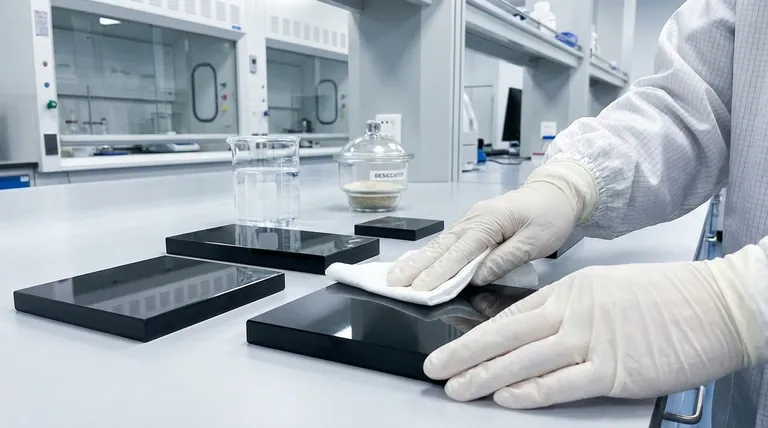To properly prepare carbon materials before use, the standard procedure is to gently wipe the surface with a dust-free cloth. This simple action is crucial for removing surface-level contaminants such as dust, oils from handling, and other loose impurities that can significantly compromise the material's intended performance.
The goal of pre-use preparation is not merely to "clean" the material, but to ensure its structural integrity and chemical purity. This is best achieved through a two-step process: a thorough physical inspection for defects followed by a gentle surface wipe to remove contaminants without damaging the material itself.

The Importance of Material Integrity
Proper preparation is the foundation for achieving reliable and repeatable results. Contaminants, even microscopic ones, can have an outsized negative impact on performance.
Why Contamination Matters
Surface impurities can block the porous structure of carbon materials, which is often essential for their function. This blockage can increase electrical resistance, reduce the available surface area for reactions, and introduce unwanted chemical side-reactions in sensitive applications like batteries or sensors.
Common Contaminants to Remove
The primary targets for pre-use cleaning are dust from the environment, oils and residues from human handling, and any loose fibers or particles from the manufacturing or cutting process.
The Standard Preparation Protocol
Follow this simple but critical sequence to ensure your carbon material is ready for its application.
Step 1: Thorough Visual Inspection
Before any cleaning, carefully inspect the material. For carbon cloth or paper, look for any tears, creases, or physical damage. For carbon felt, check for areas with significant loose fibers that could detach during use.
Step 2: Gentle Surface Wiping
Using a lint-free or dust-free cloth, gently wipe the entire surface of the material. Apply light pressure to dislodge and remove particles without abrading or damaging the carbon structure. Do not use standard paper towels, as they can shed fibers and introduce new contamination.
Step 3: Confirm Environmental Tolerances
As a final preparation step, confirm that your intended operating conditions—specifically temperature and humidity—are within the material's specified tolerance range. Using a material outside its limits can lead to degradation and failure.
Understanding the Pitfalls and Limitations
Cleaning is a simple concept, but mistakes can be costly. Knowing what to avoid is as important as knowing what to do.
Avoid Aggressive Solvents
Unless your specific, advanced application calls for it, avoid using acidic or alkaline solvents. These chemicals can react with the carbon surface, altering its properties or leaving behind residues that are more detrimental than the original dust. For post-use cleaning, only deionized water is recommended.
Cleaning vs. Activation
This pre-use wipe is a physical cleaning procedure. It should not be confused with material activation, which is a far more complex chemical or thermal process designed to intentionally modify the material's porosity and surface chemistry. Simple wiping does not "activate" the carbon.
The Risk of Cross-Contamination
The purpose of cleaning is to remove impurities, not introduce new ones. Always use a clean, dedicated, lint-free cloth. Handling the material with bare hands after cleaning will reintroduce oils and should be avoided.
Making the Right Choice for Your Application
Your preparation process should align directly with the sensitivity and goal of your project.
- If your primary focus is a general mechanical or thermal application: A thorough visual inspection and a careful wipe-down with a dust-free cloth is typically sufficient to ensure good performance.
- If your primary focus is a high-sensitivity electrochemical use (e.g., electrodes, fuel cells, sensors): Meticulous inspection and wiping are the mandatory first steps, but always verify if your specific protocol requires more advanced techniques like vacuum baking to remove volatiles.
- If your primary focus is material reusability: A post-use rinse with deionized water followed by air-drying is the standard, but always ensure this is safe and will not react with any chemicals from the previous experiment.
Ultimately, proper material preparation is the first and most critical step in guaranteeing the validity of your work.
Summary Table:
| Step | Action | Key Consideration |
|---|---|---|
| 1 | Visual Inspection | Check for tears, creases, or loose fibers. |
| 2 | Surface Wiping | Use a lint-free cloth; avoid paper towels. |
| 3 | Confirm Conditions | Ensure temperature/humidity are within tolerance. |
| Avoid | Aggressive Solvents | Can damage the material; use only if specified. |
| Note | Not Activation | This is a physical clean, not a chemical process. |
Achieve reliable, repeatable results in your lab. Properly prepared materials are the foundation of successful experiments. KINTEK specializes in high-purity lab equipment and consumables, including carbon materials, to meet the stringent demands of electrochemical, thermal, and mechanical applications. Let our experts help you select the right materials and optimize your preparation protocols. Contact KINTEK today to discuss your specific laboratory needs!
Visual Guide

Related Products
- Glassy Carbon Sheet RVC for Electrochemical Experiments
- Custom PTFE Teflon Parts Manufacturer Corrosion Resistant Cleaning Rack Flower Basket
- Custom PTFE Teflon Parts Manufacturer for Hollow Cleaning Basket and Rack Carrier
- Custom Machined and Molded PTFE Teflon Parts Manufacturer for Laboratory ITO FTO Conductive Glass Cleaning Flower Basket
- Custom PTFE Teflon Parts Manufacturer for PTFE Mesh F4 Sieve
People Also Ask
- What is the applicable potential range for an RVC glassy carbon sheet? Master Your Electrochemical Analysis
- What are the fundamental characteristics of glassy carbon? Discover its Unique Synergy of Properties
- What is the ideal operating environment for a glassy carbon sheet? Ensure Optimal Performance and Longevity
- What are the typical physical specifications for glassy carbon sheets? Unlock Superior Performance for Your Lab
- What is the porosity of an RVC glassy carbon sheet? Understanding the Critical Difference Between PPI and Porosity

















